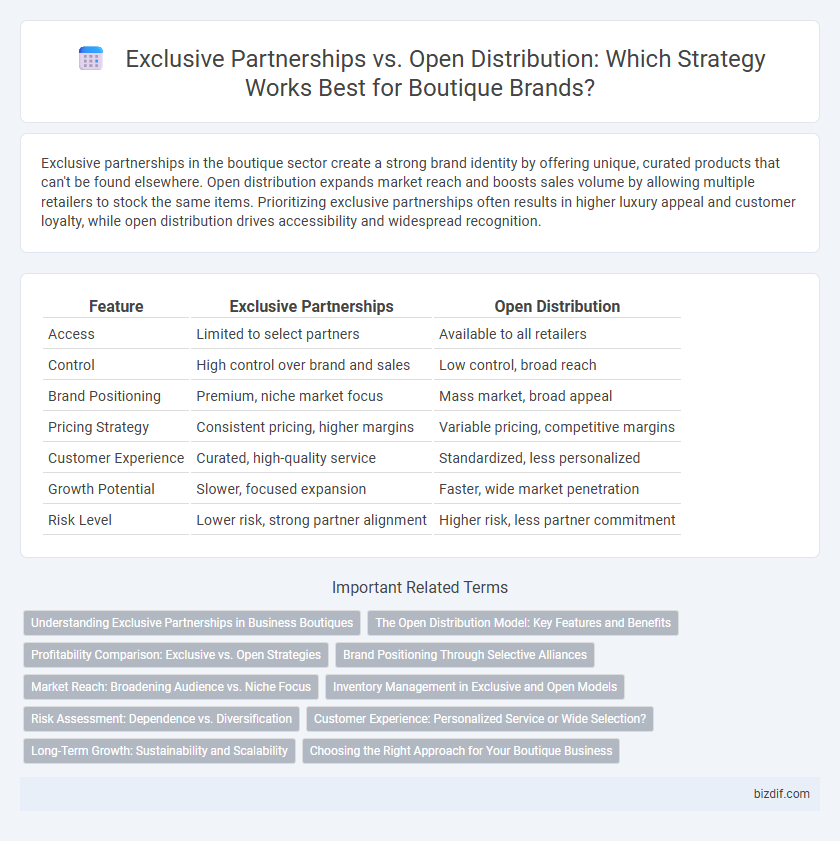Exclusive partnerships in the boutique sector create a strong brand identity by offering unique, curated products that can't be found elsewhere. Open distribution expands market reach and boosts sales volume by allowing multiple retailers to stock the same items. Prioritizing exclusive partnerships often results in higher luxury appeal and customer loyalty, while open distribution drives accessibility and widespread recognition.
Table of Comparison
| Feature | Exclusive Partnerships | Open Distribution |
|---|---|---|
| Access | Limited to select partners | Available to all retailers |
| Control | High control over brand and sales | Low control, broad reach |
| Brand Positioning | Premium, niche market focus | Mass market, broad appeal |
| Pricing Strategy | Consistent pricing, higher margins | Variable pricing, competitive margins |
| Customer Experience | Curated, high-quality service | Standardized, less personalized |
| Growth Potential | Slower, focused expansion | Faster, wide market penetration |
| Risk Level | Lower risk, strong partner alignment | Higher risk, less partner commitment |
Understanding Exclusive Partnerships in Business Boutiques
Exclusive partnerships in business boutiques create a unique value proposition by limiting distribution to select collaborators, enhancing brand prestige and customer loyalty. These partnerships facilitate tailored marketing strategies and personalized customer experiences, driving higher margins and stronger market positioning. Understanding the dynamics of exclusive agreements is crucial for boutiques aiming to differentiate in competitive retail environments.
The Open Distribution Model: Key Features and Benefits
The open distribution model in boutique retail prioritizes wide accessibility by allowing multiple sales channels including online platforms, third-party retailers, and physical stores, significantly expanding market reach and consumer engagement. This approach enhances product visibility and accelerates brand growth by leveraging diverse distribution networks without the exclusivity constraints found in exclusive partnerships. By embracing open distribution, boutiques benefit from increased sales opportunities, greater customer convenience, and a flexible supply chain that adapts to changing market demands.
Profitability Comparison: Exclusive vs. Open Strategies
Exclusive partnerships in boutiques often result in higher profit margins due to premium pricing and brand prestige, attracting affluent clientele willing to pay more for unique products. Open distribution increases sales volume by reaching broader markets but typically lowers profitability per item because of competitive pricing and distribution fees. Data from the luxury retail sector shows exclusive strategies can boost profit margins by up to 20% compared to open distribution methods.
Brand Positioning Through Selective Alliances
Selective alliances in boutique brand positioning enhance exclusivity by partnering with a limited number of high-profile retailers, reinforcing a premium image and fostering customer loyalty. Exclusive partnerships enable tight control over brand presentation, ensuring consistent messaging and elevated perceived value. Open distribution risks brand dilution by increasing availability, potentially undermining the boutique's unique market niche and reducing perceived luxury.
Market Reach: Broadening Audience vs. Niche Focus
Exclusive partnerships enable boutiques to cultivate a niche focus by targeting a specific, loyal customer base, enhancing brand prestige and perceived value. Open distribution broadens market reach, allowing access to a larger and more diverse audience, which can increase sales volume and brand awareness. Balancing these strategies depends on whether the boutique prioritizes exclusivity or widespread market penetration.
Inventory Management in Exclusive and Open Models
Exclusive partnerships streamline inventory management by limiting product availability to select retailers, enabling precise demand forecasting and reducing overstock risks. Open distribution expands market reach but introduces inventory complexities due to diverse sales channels requiring robust real-time tracking systems. Efficient inventory control in both models hinges on integrated software solutions to maintain optimal stock levels and minimize holding costs.
Risk Assessment: Dependence vs. Diversification
Exclusive partnerships concentrate risk by increasing dependence on a limited number of high-value boutique brands, potentially exposing the business to supply chain disruptions or brand-specific market fluctuations. Open distribution enhances diversification, spreading risk across multiple suppliers and reducing vulnerability to individual partner instability. Carefully assessing the trade-off between concentrated brand loyalty and diversified supplier networks enables boutiques to optimize operational resilience and market responsiveness.
Customer Experience: Personalized Service or Wide Selection?
Exclusive partnerships in boutiques ensure personalized service by fostering deep brand knowledge and tailored customer interactions, enhancing the overall shopping experience. Open distribution emphasizes a wide selection, offering diverse products that cater to varied tastes and preferences but may lack individualized attention. Balancing exclusivity with assortment breadth is crucial for boutiques aiming to optimize customer satisfaction and loyalty.
Long-Term Growth: Sustainability and Scalability
Exclusive partnerships foster long-term growth by building strong brand loyalty and ensuring controlled, consistent customer experiences that sustain premium value. Open distribution enables scalability by expanding market reach quickly but may dilute brand identity and reduce sustainability due to inconsistent quality control. Balancing exclusivity with selective expansion strategies enhances both sustainable growth and scalable market presence for boutique brands.
Choosing the Right Approach for Your Boutique Business
Exclusive partnerships enhance a boutique's brand luxury by aligning with select designers and limiting product availability to maintain exclusivity. Open distribution increases market reach and scalability by offering diverse products across multiple platforms, attracting a broader customer base. Selecting the right approach depends on your boutique's target audience, brand identity, and long-term growth strategy to balance exclusivity with accessibility.
Exclusive Partnerships vs Open Distribution Infographic

 bizdif.com
bizdif.com